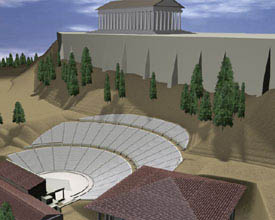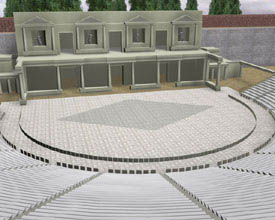
 |
The Theater of Dionysus Eleuthereus in Athens has to be one of the most problematic archaeological sites in the Greek world. All that remains of the theater for which Aeschylus, Sopho-cles, Euripides, and Aristophanes composed their works are six stones demarcating the original orchestra.(1) Nor are the later phases of the building well preserved, and it is not always easy to tell which of the remaining foundation stones and columns dates from which era. As a result, there are nearly as many different reconstructions of the Theater of Dionysus as there are scholars interested in the building; some of the reconstruction drawings present architectural impossibilities or run contrary to the practical needs of performers and spectators.
To provide their students with a sense of what it was like to be part of the Athenian audience, many teachers of ancient theater resort to showing photographs of the theater at Epidauros. While the annual theatrical festivals held in the ancient theater at Epidauros unmistakably provide the closest modern equivalent to the original acting space of the Greek dramas, the theater itself is of late date, built at a time when stagecraft and the priorities of dramatists had undergone substantial changes. The authors concluded that technology had advanced, by 1994, to the point that 3D computer modeling could provide a more satisfactory solution to the problem of presenting, exploring, and researching a nonexistent building. (2)
 Fig. 1 The Theater of Dionysus in Athens with Acropolis in Background - Roman Period Restoration
Fig. 1 The Theater of Dionysus in Athens with Acropolis in Background - Roman Period RestorationWe planned to produce a complete CD-ROM dedicated to using models of this sort to teach ancient theater but were unable at that time to follow through with it due to our other commitments. Early in 1997, however, we decided to make some preliminary models of the Theater of Dionysus with 3D Studio MAX, a modeling, rendering, and animation program from Kinetix (a division of Autodesk) for publication in Didaskalia, the electronic journal of ancient theater in modern performance. We had no funding or official sponsorship. Our team consisted of one performance-oriented classical philologist (Goetsch) and one professional computer graphics expert (Didak). The equipment we have used is our own, (3) and our early research was confined to books we owned, photocopies made at an earlier date, slides and photographs from our personal collections, Didaskalia, and such books and journals as were available in the University of Warwick library.
Our focus was always on the Theater of Dionysus as a performance space. The model was seen as a means by which to achieve a better understanding of ancient plays and acting techniques, and Didaskalia's permanent Web site was already acting as a way to make such information available to others. While it is not possible to exploit the full potential of a three-dimensional model via the World Wide Web, image files created from such a model can still be more informative than our only other visual evidence, vase-paintings. Fully animated models which the user can manipulate will be implemented when there is evidence of demand sufficient to justify the production of a commercial CD-ROM.
At the earliest stage we worked with drawings, photographs and plans from a variety of sources. (4) Most of the sources based their drawings on the original excavations of Dörpfeld and Fiechter in the late nineteenth century. None contained the kind of small-scale topographical information best suited to 3D modeling, and some proved to be internally inconsistent. We have not been able to locate any digital geographical information for the area to supplement our sources. As a result, many parts of the model had to be approximated by taking an average of the various drawings, plans, and descriptions. This made modeling of the south slope of the Acropolis a very difficult task and caused us to begin our reconstructions with the latest, rather than the earliest, phase of the theater. (5)
We included very basic models of the Parthenon and the Odeion of Pericles, but not the Temple or Stoa of Dionysus. Even with the theater surroundings incomplete and without the marble thrones for the first two rows of seats, the model quickly grew into a monster that required 30 minutes to create a single rendered image. Several renderings of this model were then placed on the Didaskalia Web site and can be viewed at http://didaskalia.berkeley.edu/stagecraft/TDA/tdamain.html.
 Fig. 2 The Theater of Dionysus in Athens - Roman Period Restoration
Fig. 2 The Theater of Dionysus in Athens - Roman Period RestorationUnfortunately, we know very little about the use to which this final phase of the Theater of Dionysus, the Neronian/Hadrianic rebuilding, was put, but we can be certain from its design that it was not built with the works of Aristophanes and the three great tragedians in mind. Thus, the images currently on the Web site, while attractive, must be used with care if confusion is to be avoided. Nevertheless they demonstrate the usefulness of this kind of modeling for visualizing the circumstances of production in antiquity and may prove useful to those who study the theaters of imperial Rome.
As work progressed, it became clear both that we would have to create separate models for the smaller details of the theater and that we needed to enlist the help of archaeologists in finding better source material. While we were generally pleased with the quality of the images, we knew that they still lacked the degree of accuracy that we wanted and that this problem would only become more acute as we moved backwards in time. In April of 1997 Didaskalia received an advance copy of David Wiles' Tragedy in Athens from Cambridge University Press, and we discovered that he had done extensive and invaluable research on the subject of the Theater of Dionysus and come to some of the same conclusions we had about many of our sources. We promptly enlisted Mr. Wiles, who teaches in the Drama department at Royal Holloway College, University of London, as a consultant and have been making use of new source material mentioned in his book, the most important of which are Manolis Korres' recent excavations and surveys.
Working and conversing with Mr. Wiles convinced us that in order to provide a proper performance setting we would need to include the Precinct of Dionysus, the Street of Tripods, and the Odeion of Perikles in our final models, because all three areas served important functions in the dramatic festivals. This, of course, leads us yet deeper into architectural waters and problems such as the tentlike roof of the Odeion. We had already begun work on reconstructing the Hellenistic skene and the Lycurgan skene when we first entered into discussion with Harrison Eiteljorg II, who pointed out steps which we should take if we wish our models to be useful to archaeologists as well as students of theater history.
We intend therefore to publish information about the dimensions of the building as well as an extensive annotated bibliography. We will also produce line drawings based on our models. We do not at present have plans to make the model itself available on the Didaskalia Web site. Before we can supplement or replace the existing images we need to make sure that the models we create are as accurate as possible, which means returning to the research process. We welcome all contributions and suggestions from the readers of this newsletter and any suggestions for further reading, but we ask that you be patient with delays in implementing new features.
Sallie Goetsch
Stefan Didak
To send comments or questions to Sallie Goetsch, please see our email contacts page.
For other Newsletter articles concerning the use of electronic media in the humanities or issues involving CAD in archaeology and architectural history, consult the Subject index.
Next Article: Database Design: It's Never As Easy As It Looks
Table of Contents for the Fall, 1997 issue of the CSA Newsletter (Vol. X, no. 2)
![]() Table of Contents for all CSA Newsletter issues on the Web
Table of Contents for all CSA Newsletter issues on the Web
(1)
Our reconstructions are based on the belief that Dörpfeld, not Fiechter, correctly interpreted the meaning and function of these stones and the placement of the original orchestra. For a good recent argument in favor of accepting Dörpfeld's orchestra, see David Wiles, Tragedy in Athens (Cambridge 1997), pp. 44ff. Return to body of article.(2)
Cf. Stefan Didak and Sallie Goetsch, "Animating Ancient Theater Through Computer Graphics," Didaskalia 1.5 (December, 1994), http://didaskalia.berkeley.edu/issues/vol1no5/Animating.html. Return to body of article.(3)
The system used to create the images shown here was a multiprocessor Pentium Pro 200Mhz system with two processors, 128MB of RAM, and a Diamond FireGL-3000 OpenGL 3D hardware accelerator. A system like this can be considered a high end workstation at the PC level but really fits in nicely with the use of 3D Studio MAX. The display speed of such a system for editing and modeling is invaluable and gave us the potential to model things, render them quickly, and adjust various bits as needed. Given the dense complexity of the model and its data, the minimum hardware necessary for creating this model would be a single processor Pentium, 150Mhz, with 64MB RAM. Return to body of article.(4)
Pickard-Cambridge's The Theatre of Dionysus in Athens (Oxford 1946), Luigi Polacco's Il teatro di Dioniso eleutereo ad Atene (Rome 1990), John Travlos' Pictorial Dictionary of Ancient Athens (New York 1971), George Izenour's Theater Design, 2d ed. (Yale 1997) and the Leacrofts' Theatre and Playhouse: An Illustrated Survey of Theatre Buildings from Ancient Greece to the Present Day (Methuen 1985). Return to body of article.(5)
For details of the process see http://didaskalia.berkeley.edu/stagecraft/TDA/how.html, or contact Stefan Didak directly at sdidak@euronet.nl. Return to body of article.